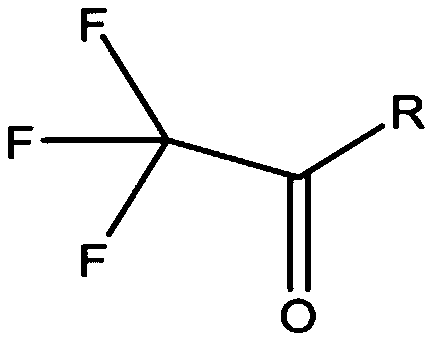A solvent-free silicone release agent with light peeling force, its preparation method and application
A solvent-free, light peeling technology, applied in the direction of coating, film/sheet release liner, etc., can solve problems such as the inability to achieve ultra-light release force, and meet the requirements of ultra-light peel force and release performance. stable effect
- Summary
- Abstract
- Description
- Claims
- Application Information
AI Technical Summary
Problems solved by technology
Method used
Image
Examples
Embodiment 1
[0034] A preparation of a solvent-free silicone release agent with light peeling force, the specific steps are as follows, parts by mass:
[0035] 1) According to the functional group ratio H / Vi=1.5, 100 parts of vinyl polysiloxane and 7 parts of hydrogen-containing polysiloxane;
[0036] 2) 10 parts of anchoring agent (3-glycidyl etheroxypropyl triethoxysilane), 3 parts of fluorine-containing release force regulator (4-ethoxy-1,1,1-trifluoro-3- buten-2-one);
[0037] 3) 5 parts of platinum catalysts;
[0038] 4) Mix the proportions of steps 1) 2) 3) according to the above experimental steps to prepare a release agent.
[0039] 5) Coat the release agent in step 4) on the glassine paper with a coater, and cure at 150° C. for 30 seconds to obtain a release paper. The normal temperature peeling force of the obtained release paper is 3g / 25mm, and the aging peeling force is 3.5g / 25mm.
Embodiment 2
[0041] A preparation of a solvent-free silicone release agent with light peeling force, the specific steps are as follows, parts by mass:
[0042] 1) According to the functional group ratio H / Vi=1.5, 100 parts of vinyl polysiloxane and 7 parts of hydrogen-containing polysiloxane;
[0043] 2) 10 parts of anchoring agent (3-glycidyl etheroxypropyl triethoxysilane), 8 parts of fluorine-containing release force regulator (4-butoxy-1,1,1-trifluoro-3- buten-2-one);
[0044] 3) 5 parts by weight of platinum catalysts;
[0045] 4) Mix the proportions of steps 1) 2) 3) according to the above experimental steps to prepare a release agent.
[0046] 5) Coat the release agent in step 4) on the glassine paper with a coater, and cure at 150° C. for 30 seconds to obtain a release paper. The normal temperature peeling force of the obtained release paper is 1.3g / 25mm, and the aging peeling force is 1.7g / 25mm.
Embodiment 3
[0048] A preparation of a solvent-free silicone release agent with light peeling force, the specific steps are as follows, parts by mass:
[0049] 1) According to the functional group ratio H / Vi=2, 100 parts of vinyl polysiloxane and 9 parts of hydrogen-containing polysiloxane;
[0050] 2) 10 parts of anchoring agent (3-glycidyl etheroxypropyl triethoxysilane), 8 parts of fluorine-containing release force regulator (1,1,1-trifluoro-3-hepten-2-one );
[0051] 3) 5 parts by weight of platinum catalysts;
[0052] 4) Mix the proportions of steps 1) 2) 3) according to the above experimental steps to prepare a release agent.
[0053] 5) Coat the release agent in step 4) on the glassine paper with a coater, and cure at 150° C. for 30 seconds to obtain a release paper. The normal temperature peeling force of the obtained release paper is 1.8g / 25mm, and the aging peeling force is 2.4g / 25mm.
PUM
 Login to View More
Login to View More Abstract
Description
Claims
Application Information
 Login to View More
Login to View More - R&D
- Intellectual Property
- Life Sciences
- Materials
- Tech Scout
- Unparalleled Data Quality
- Higher Quality Content
- 60% Fewer Hallucinations
Browse by: Latest US Patents, China's latest patents, Technical Efficacy Thesaurus, Application Domain, Technology Topic, Popular Technical Reports.
© 2025 PatSnap. All rights reserved.Legal|Privacy policy|Modern Slavery Act Transparency Statement|Sitemap|About US| Contact US: help@patsnap.com


